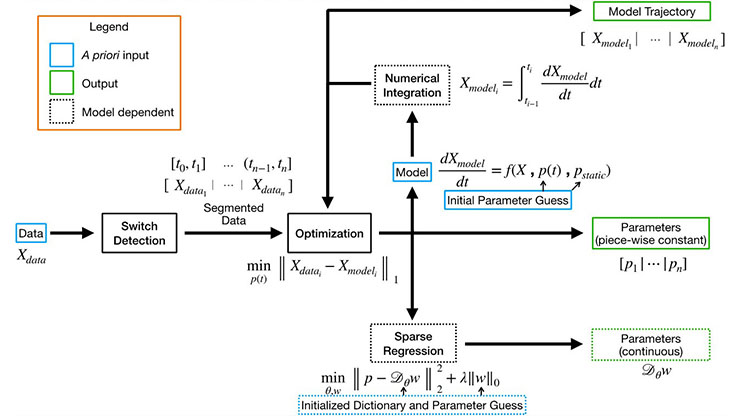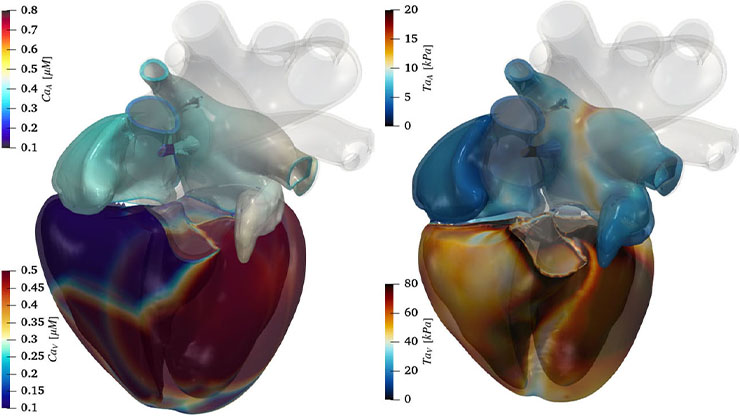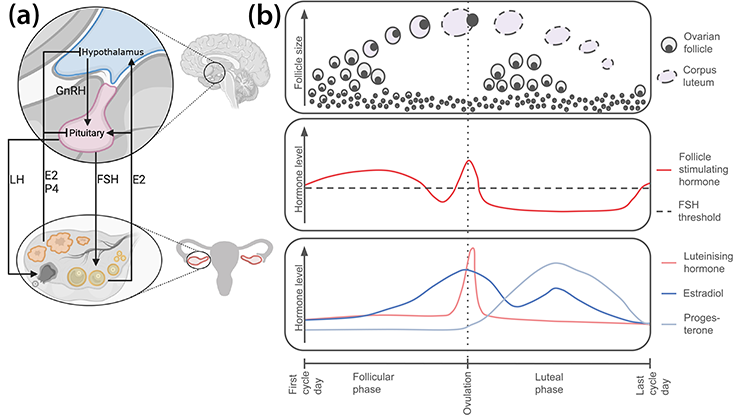Computational Modeling Uncovers Key Sex Differences in Common Heart Rhythm Disorders
Biological sex is a key variable that can significantly impact disease occurrence, presentation, and prognosis. However, females are severely underrepresented in both fundamental disease research and clinical trials. For example, a 2016 review article revealed that less than 30 percent of basic cardiovascular research studies reported the use of either female subjects or subjects of multiple sexes [1]; a similarly low percentage of women are included in clinical cardiovascular studies. Yet the risk of death from cardiovascular disease is not lower in females. In fact, women account for more than 50 percent of deaths due to certain cardiovascular diseases, including atrial fibrillation (AF): a widespread disorder that is characterized by very fast, irregular beating in the upper chambers of the heart.
The function of the heart as a mechanical pump is critically dependent on its electrical activity. At the cellular level, cardiomyocytes (heart cells that are responsible for contraction) respond to external electric stimuli to generate transient depolarization and repolarization in the voltage difference across the cell membrane. Through bidirectional coupling, the resulting action potentials (APs) prompt transient alterations in intracellular calcium (Ca2+) signaling that act on the contractile machinery of myofilaments to mediate contraction and subsequent relaxation. As such, a synchronized and coordinated electrical excitation of cardiomyocytes is crucial for normal contractile function within the heart. Disruptions to electrical excitation patterns cause disorders in the heart rhythm that are known as cardiac arrhythmias.
AF is the most common form of arrhythmia. Characterized as a global epidemic, this disease is projected to become three times as prevalent over the next 50 years [4]. AF predisposes patients to heart failure and stroke, thereby causing significant morbidity and mortality; it also imposes a substantial socioeconomic burden on healthcare systems. Mechanistically, AF is associated with molecular changes that shorten the duration of APs and disrupt Ca2+ signaling, thus promoting reentry and triggering activity that underlies AF initiation and maintenance. Unfortunately, existing AF therapies are not particularly efficacious and are often accompanied by adverse effects [7]. Poorly understood interpatient differences in disease phenotypes further complicate the development of effective AF therapeutics.
Substantial sex-related differences exist in the incidence, clinical manifestation, management, and treatment outcomes of AF. Although men tend to develop AF much earlier than women, women often experience heightened symptoms, a more severely diminished quality of life, more treatment-based complications, and a greater risk of AF-related stroke and mortality [3]. Furthermore, the underrepresentation of females in both basic and clinical cardiovascular research may lead to an inappropriate extrapolation of study outcomes from men to women [6]. As a consequence, women often obtain less effective and even potentially harmful treatments that can lead to worse prognoses. A systematic investigation of the sex differences in AF is necessary to discover the precise mechanisms of sex-based disparities, develop sex-specific therapeutic strategies, and ultimately improve treatment outcomes.
![<strong>Figure 1.</strong> Sex-specific models of human atrial myocytes that incorporate sex-divergent parameters in a three-dimensional spatiotemporal model of stochastic calcium (Ca<sup>2+</sup>) signaling for human atrial cardiomyocytes. The models feature bidirectional coupling of voltage and Ca<sup>2+</sup> signaling, stochastic modeling of ryanodine receptors, L-type Ca<sup>2+</sup> channels, and realistic tubular structure. Figure adapted from [10].](/media/d0rhewdc/figure1.jpg)
Experimental work has identified considerable sex-based differences in the molecular and structural underpinnings of functional cardiomyocytes in the atria of humans and animals, namely in the expression and phosphorylation of Ca2+-handling proteins [2], t-tubular system density [9], and cell dimensions [5, 8, 9] — all of which may be altered by AF. For instance, AF reduces the L-type Ca2+ current—i.e., the main pathway for intracellular Ca2+ entry—in the cardiomyocytes of males but not females. In parallel, atrial cardiomyocytes in females with AF display a greater incidence of Ca2+ instabilities than in males [2]. However, it is difficult to gain a systematic understanding of sex-based differences in the phenotypes of both normal and diseased atria at the cellular level, or to experimentally delineate various factors’ precise contributions to sex-based differences in AF. Yet despite these challenges, computational models have emerged as a powerful tool for unraveling the subcellular mechanisms of Ca2+ dysregulation.
For our study, we built a family of computational models of human atrial cardiomyocyte electrophysiology and Ca2+ signaling in males and females (see Figure 1), then used these models to systematically assess the mechanisms of Ca2+-dependent arrhythmia in male and female atrial cardiomyocytes. In particular, we describe the myocyte electrophysiology via a system of ordinary differential equations that represent the biophysically accurate features of bioelectric “effectors” — namely ion channels, transporters, exchangers, and the dynamical regulation of intracellular ion concentrations. Consider the critical role of subcellular Ca2+ signaling and its spatial heterogeneity in shaping normal function and mediating arrhythmias through the bidirectional coupling between transmembrane voltage and Ca2+. A three-dimensional spatial representation of myocyte Ca2+ signaling is thus essential when describing (i) the subcellular gradients of key Ca2+ signaling proteins, e.g., ryanodine receptors (RyRs) and calsequestrin; and (ii) highly irregular subcellular structures—e.g., tubular structures that are membrane invaginations and provide coupling between processes on cell membranes and within the cell—that are impaired by disease.
We simulate major Ca2+ channels stochastically, employing Markov chain models to describe the open/close behaviors of RyRs and individual L-type Ca2+ channels and solving them with Monte Carlo stochastic simulations. These stochastic computational models allow us to simulate key AF-promoting events of Ca2+ sparks and waves, which are highly random in nature. By incorporating mathematical descriptions of known sex-based differences in the expression, function, and/or spatial arrangements of “effectors” of electrophysiology and Ca2+ signaling (and their modifications in AF), we successfully built male- and female-specific models for both normal and AF conditions.
First, we demonstrated that these novel, sex-specific models of human atrial cells could reproduce experimental findings to ensure the computational models’ robustness and credibility. Our models detected no sex difference in the Ca2+ spark incidence of normal atria but did reveal a substantially higher Ca2+ spark abundance in female versus male atrial cells; these simulated results aligned well with previous experimental studies [2], attesting to the models’ validity. Using a protocol that mimics the fast, irregular electrical activity that occurs during AF, we subsequently applied the models to evaluate the sex-dependent propensity to Ca2+-driven arrhythmic events. This investigation showed that arrhythmic events are more frequent in female atrial myocytes, especially during high-rate electrical activation. Our simulations also suggested that female myocytes experience more irregularity in Ca2+ signaling behaviors on a beat-to-beat basis (see Figure 2).
![<strong>Figure 2.</strong> Our computational simulations revealed heightened calcium (Ca<sup>2+</sup>)-driven arrhythmic events and increased beat-to-beat variability of Ca<sup>2+</sup> transient in female versus male atria with atrial fibrillation. Figure adapted from [10].](/media/4dtbapin/figure2.jpg)
These results indicate that Ca2+-dependent arrhythmogenesis might be the dominant AF-promoting mechanism in female atria. Because Ca2+-driven arrhythmic events trigger ectopic activity in the heart, our findings have significant implications for our overall understanding of pathological mechanisms that give rise to greater nonconventional AF triggers in the atria of female versus male patients. They also explain why existing treatment options—which generally do not address Ca2+-dependent ectopic activity—are less effective for female patients. Furthermore, our computational modeling approach allowed us to conduct sensitivity analyses, which are often not feasible in experimental methods; these analyses precisely quantified the contribution of each sex-dependent factor to the simulated sex-divergent disease phenotypes. This capability helps us quantitatively and mechanistically identify the major components that drive sex differences, thereby informing the development of targeted therapeutic strategies.
Our computational modeling approach also enabled the discovery of potential therapeutic strategies to treat AF in women. Given the heightened level of Ca2+-dependent AF-promoting phenotypes in female atria, treatment for female patients should prioritize the suppression of Ca2+-dependent arrhythmia. Our simulations demonstrate that targeting the t-tubular system and Ca2+-handling machinery could substantially attenuate Ca2+-dependent arrhythmic events and dysfunction. Moreover, combined interventions for multiple targets were more effective than single-target strategies. Although these results recommend Ca2+-directed therapeutic strategies as a promising anti-AF approach for female patients, they also underscore the need for further fundamental and clinical studies to ultimately develop sex-specific management strategies for AF.
Overall, our study confirmed that sex-specific models are instrumental in our ongoing goal to quantitatively uncover sex-based mechanisms in AF and identify novel therapeutic strategies. While it is of course imperative to include more female subjects in future fundamental and clinical cardiovascular wet lab studies, our work strongly advocates for the development of sex-specific models in dry lab research to better understand the influence of sex as a biological variable.
This study was conducted by Xianwei Zhang, Yixuan Wu, Charlotte Smith, Stefano Morotti, Eleonora Grandi, and Haibo Ni of the University of California, Davis; William Louch of Oslo University Hospital and the University of Oslo; and Dobromir Dobrev of the University of Duisburg-Essen. A complete manuscript for the work is available in [10].
Haibo Ni delivered a minisymposium presentation on this research at the 2024 SIAM Annual Meeting, which took place in Spokane, Wash., last year.
Acknowledgments: This work was supported by American Heart Association Career Development Award 24CDA1258695, postdoctoral fellowships 20POST35120462 and 24POST1195229, and predoctoral fellowship 20PRE35120465; National Institutes of Health (NIH)/National Heart, Lung, and Blood Institute grants R01HL131517, R01HL170521, R01HL141214, P01HL141084, R01HL136389, R01HL089598, R01HL163277, R01HL160992, R01HL165704, and R00HL138160; NIH Stimulating Peripheral Activity to Relieve Conditions grant 1OT2OD026580-01; the Research Council of Norway; the University of California, Davis School of Medicine Dean’s Fellow Award; the European Union large-scale integrative project MAESTRIA no. 965286; the Burroughs Wellcome Fund; and a Doris Duke Charitable Foundation "COVID-19 Fund to Retain Clinical Scientists" award.
References
[1] Flórez-Vargas, O., Brass, A., Karystianis, G., Bramhall, M., Stevens, R., Cruickshank, S., & Nenadic, G. (2016). Bias in the reporting of sex and age in biomedical research on mouse models. eLife, 5, e13615.
[2] Herraiz-Martínez, A., Tarifa, C., Jiménez-Sábado, V., Llach, A., Godoy-Marín, Colino-Lage, H., … Hove-Madsen, L. (2022). Influence of sex on intracellular calcium homoeostasis in patients with atrial fibrillation. Cardiovasc. Res., 118(4), 1033-1045.
[3] Ko, D., Rahman, F., Schnabel, R.B., Yin, X., Benjamin, E.J., & Christophersen, I.E. (2016). Atrial fibrillation in women: Epidemiology, pathophysiology, presentation, and prognosis. Nat. Rev. Cardiol., 13(6), 321-332.
[4] Kornej, J., Börschel, C.S., Benjamin, E.J., & Schnabel, R.B. (2020). Epidemiology of atrial fibrillation in the 21st century: Novel methods and new insights. Circ. Res., 127(1), 4-20.
[5] Thibault, S., Ton, A.-T., Huynh, F., & Fiset, C. (2022). Connexin lateralization contributes to male susceptibility to atrial fibrillation. Int. J. Mol. Sci., 23(18), 10696.
[6] Tobb, K., Kocher, M., & Bullock-Palmer, R.P. (2022). Underrepresentation of women in cardiovascular trials — it is time to shatter this glass ceiling. Am. Heart J. Plus: Cardiol. Res. Pract., 13(8), 100109.
[7] Turagam, M.K., Musikantow, D., Whang, W., Koruth, J.S., Miller, M.A., Langan, M.-N., … Reddy, V.Y. (2021). Assessment of catheter ablation or antiarrhythmic drugs for first-line therapy of atrial fibrillation: A meta-analysis of randomized clinical trials. JAMA Cardiol., 6(6), 697-705.
[8] Winters, J., Isaacs, A., Zeemering, S., Kawczynski, M., Maesen, B., Maessen, J., … Schotten, U. (2023). Heart failure, female sex, and atrial fibrillation are the main drivers of human atrial cardiomyopathy: Results from the CATCH ME consortium. J. Am. Heart Assoc., 12(22), e031220.
[9] Yue, X., Zhang, R., Kim, B., Ma, A., Philipson, K.D., & Goldhaber, J.I. (2017). Heterogeneity of transverse-axial tubule system in mouse atria: Remodeling in atrial-specific Na+-Ca2+ exchanger knockout mice. J. Mol. Cell. Cardiol., 108, 50-60.
[10] Zhang, X., Wu, Y., Smith, C.E.R., Louch, W.E., Morotti, S., Dobrev, D., …, Ni, H. (2024). Enhanced Ca2+-driven arrhythmogenic events in female patients with atrial fibrillation: Insights from computational modeling. JACC Clin. Electrophysiol., 10(11), 2371-2391.
About the Author
Haibo Ni
Faculty member, Nanjing University
Haibo Ni is a faculty member at the Medical School of Nanjing University in China, prior to which he was an assistant project scientist in the Department of Pharmacology at the University of California, Davis. His research focuses on the development and application of multiscale and multiphysics heart models to investigate disease mechanisms and advance therapeutic strategies.

Stay Up-to-Date with Email Alerts
Sign up for our monthly newsletter and emails about other topics of your choosing.






